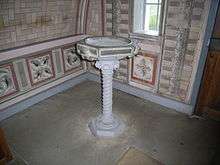Italian Chapel

The Italian Chapel is a highly ornate Catholic chapel on Lamb Holm in the Orkney Islands. It was built during World War II by Italian prisoners of war, who were housed on the previously uninhabited island while they constructed the Churchill Barriers to the east of Scapa Flow. Only the concrete foundations of the other buildings of the prisoner-of-war camp survive. It was not completed until after the end of the war, and was restored in the 1960s and again in the 1990s. It is now a popular tourist attraction, and a category A listed building.[1]
Construction
550 Italian prisoners of war, captured in North Africa during World War II, were brought to Orkney in 1942. They worked on the construction of the Churchill Barriers, four causeways created to block access to Scapa Flow.[2] 200 were based at Camp 60 on Lamb Holm.[3] In 1943, Major Thomas Pyres Buckland, Camp 60's new commandant, and Father Gioacchino Giacobazzi, the camp's padre, agreed that a place of worship was required.
The chapel was constructed from limited materials by the prisoners. Two Nissen huts were joined end-to-end. The corrugated interior was then covered with plasterboard and the altar and altar rail were constructed from concrete left over from work on the barriers. Most of the interior decoration was done by Domenico Chiocchetti, a prisoner from Moena.[4] He painted the sanctuary end of the chapel and fellow-prisoners decorated the entire interior. They created a facade out of concrete, concealing the shape of the hut and making the building look like a church. The light holders were made out of corned beef tins. The baptismal font was made from the inside of a car exhaust covered in a layer of concrete.
Chiocchetti remained on the island to finish decorating the newly consecrated chapel, even when his fellow prisoners were released shortly before the end of the war.[3][5]
Preservation
In 1958, the Chapel Preservation Committee was set up by a group of Orcadians. In 1960, Chiocchetti returned to assist in the restoration. He returned again in 1964, with Mrs Maria Chiocchetti, but he was too ill to travel when some of the other prisoners returned in 1992 to commemorate the fiftieth anniversary of their arrival on the island. He died in 1999. In 1996, a declaration was jointly signed by officials in Orkney and Chiocchetti's hometown of Moena, reinforcing the ties between the two places.
Today, the tin tabernacle is still used as a chapel and remains a popular tourist attraction, receiving over 100,000 visitors every year. It has become one of the best-known and moving symbols of reconciliation in the British Isles.[6]
Philip Paris wrote two books, one fiction and one non-fiction, about the building of the chapel.[7] The novel The Chapel at the Edge of the World by Kirsten Mckenzie covers the chapel's building.[8]
In 2014, a special mass was held at the chapel to mark its 70th Anniversary. [9] During the mass, Angela Chiochetti, the daughter of Domenico Chiochetti, sang "Panus Angelicus" as part of the celebration of the mass.
Media
 Front facade in 2007
Front facade in 2007- Interior metalwork detail
 War memorial, including a statue of Saint George, outside the chapel
War memorial, including a statue of Saint George, outside the chapel
See also
References
- ↑ Lamb Holm the Italian Chapel, Listed Buildings Online, retrieved 2011-06-12
- ↑ Colpi, Terri (1991). Italians Forward: a Visual History of the Italian Community in Great Britain. Mainstream. ISBN 1-85158-349-1.
- 1 2 Essential Scotland: The Miracle of Lambholm
- ↑ "Italian Chapel". Gazetteer for Scotland. Retrieved 2009-08-30.
- ↑ Orkney's Italian Chapel. P.O.W. Chapel Preservation Committee, Stromness undated, p.5
- ↑ "The history of the Italian Chapel". The Orcadian. March 2002. Retrieved 2009-08-30.
- ↑ "Philip Paris, Author: The Italian Chapel".
- ↑ House, Christian (8 August 2009). "The Chapel at the Edge of the World, By Kirsten McKenzie". The Independent. Retrieved 24 September 2016.
- ↑ "Archived copy". Archived from the original on 2016-09-27. Retrieved 2016-09-25.
External links
| Wikimedia Commons has media related to Italian Chapel. |
Coordinates: 58°53′23″N 2°53′24″W / 58.88968°N 2.89005°W
- Map sources for Italian Chapel
- Orkney’s Italian Chapel